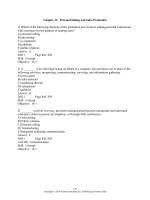Lecture Principles of Marketing - Chapter 16: Personal selling and sales promotion
Bạn đang xem bản rút gọn của tài liệu. Xem và tải ngay bản đầy đủ của tài liệu tại đây (1.02 MB, 41 trang )
i t ’s good and
good for you
Chapter Sixteen
Personal Selling
and
Sales Promotion
Copyright © 2012 Pearson Education, Inc.
Publishing as Prentice Hall
Chapter1616- 1- slide 1
Personal Selling and
Sales Promotion
•
Topic Outline
•
•
•
•
Personal Selling
Managing the Sales
Force
The Personal Selling
Process
Sales Promotion
Copyright © 2012 Pearson Education, Inc.
Publishing as Prentice Hall
16 - 2
Personal Selling
Personal Selling
Personal selling is the interpersonal part
of the promotion mix and can include:
•
Face-to-face communication
•
Telephone communication
•
Video or Web conferencing
•
Copyright © 2012 Pearson Education, Inc.
Publishing as Prentice Hall
16 - 3
Personal Selling
The Nature of Personal Selling
Salespeople are an effective link
between the company and its customers
to produce customer value and company
profit by:
•
•
•
•
Representing the company to customers
Representing customers to the company
Working closely with marketing
Copyright © 2012 Pearson Education, Inc.
Publishing as Prentice Hall
16 - 4
Managing the Sales Force
•
Sales force management is the
analysis, planning, implementation, and
control of sales force activities
Copyright © 2012 Pearson Education, Inc.
Publishing as Prentice Hall
16 - 5
Managing the Sales Force
•
Designing Sales Force Structure
Copyright © 2012 Pearson Education, Inc.
Publishing as Prentice Hall
16 - 6
Managing the Sales Force
•
Sales Force Structure
Territorial sales force structure refers to a
structure where each salesperson is
assigned an exclusive geographic area and
sells the company’s full line of products and
services to all customers in that territory
•
Defines salesperson’s job
•
Fixes accountability
•
Lowers sales expenses
•
Improves relationship building and selling
effectiveness
Copyright © 2012 Pearson Education, Inc.
Publishing as Prentice Hall
16 - 7
Managing the Sales Force
Sales Force Structure
Product sales force structure refers to a
structure where each salesperson sells
along product lines
•
Improves product knowledge
•
Can lead to territorial conflicts
•
Copyright © 2012 Pearson Education, Inc.
Publishing as Prentice Hall
16 - 8
Managing the Sales Force
•
Sales Force Structure
Customer sales force structure refers
to a structure where each salesperson
sells along customer or industry lines
•
Improves customer relationships
Copyright © 2012 Pearson Education, Inc.
Publishing as Prentice Hall
16 - 9
Managing the Sales Force
•
Sales Force Structure
Complex sales force structure refers to
a structure where a wide variety of
products is sold to many types of
customers over a broad geographic area
and combines several types of sales force
structures
Copyright © 2012 Pearson Education, Inc.
Publishing as Prentice Hall
16 - 10
Managing the Sales Force
•
Sales Force Size
Salespeople are one of the company’s
most productive and expensive assets.
•
Increases in sales force size can
increase sales and costs
•
Workload approach to sales forces
size refers to grouping accounts into
different classes to determine the
number of salespeople needed
Copyright © 2012 Pearson Education, Inc.
Publishing as Prentice Hall
16 - 11
Managing the Sales Force
•
Other Sales Force Strategy and
Structure Issues
Outside salespeople call on
customers in the field
Inside salespeople conduct business
from their offices and often provide
support for the outside salespeople
–
–
Technical sales support people
Sales assistants
Team selling is used to service large,
complex accounts
Copyright © 2012 Pearson Education, Inc.
Publishing as Prentice Hall
16 - 12
Managing the Sales Force
•
•
Recruiting and Selecting
Salespeople
• Issues in Recruiting and Selecting
Careful selection and training
•
•
increases sales performance
Poor selection
Increases recruiting and training
costs
–
–
Lost sales
Disrupts customer relationships
Copyright © 2012 Pearson Education, Inc.
Publishing as Prentice Hall
16 - 13
Managing the Sales Force
•
Salesperson compensation based
on
Copyright © 2012 Pearson Education, Inc.
Publishing as Prentice Hall
16 - 14
Managing the Sales Force
•
Supervising and Motivating
Salespeople
•
•
The goal of supervision is to help
salespeople work smart by doing
the right things in the right ways
The goal of motivation is to
encourage salespeople to work hard
and energetically toward sales force
goals
Copyright © 2012 Pearson Education, Inc.
Publishing as Prentice Hall
16 - 15
Managing the Sales Force
•
How Salespeople Spend Their Time
Copyright © 2012 Pearson Education, Inc.
Publishing as Prentice Hall
16 - 16
Managing the Sales Force
•
Selling and the Internet
Major tool to support salespeople
Copyright © 2012 Pearson Education, Inc.
Publishing as Prentice Hall
16 - 17
Managing the Sales Force
•
•
Supervising and Motivating
Salespeople
Sales morale and performance can
be increased through:
–
–
–
Organizational climate
Sales quotas
Positive incentives
Copyright © 2012 Pearson Education, Inc.
Publishing as Prentice Hall
16 - 18
Managing the Sales Force
•
Evaluating Salespeople and Sales
Force Performance
Copyright © 2012 Pearson Education, Inc.
Publishing as Prentice Hall
16 - 19
The Personal Selling Process
The goal of the personal selling process is
to get new customers and obtain orders
from them
Copyright © 2012 Pearson Education, Inc.
Publishing as Prentice Hall
16 - 20
The Personal Selling Process
•
Steps in the Personal Selling
Process
Prospecting identifies qualified
potential customers through
referrals from:
•
Customers
•
Suppliers
•
Dealers
•
Internet
Copyright © 2012 Pearson Education, Inc.
Publishing as Prentice Hall
16 - 21
The Personal Selling Process
•
Steps in the Personal Selling
Process
Qualifying is identifying good
customers and screening out poor
ones by looking at:
–
–
–
–
–
Financial ability
Volume of business
Needs
Location
Growth potential
Copyright © 2012 Pearson Education, Inc.
Publishing as Prentice Hall
16 - 22
The Personal Selling Process
Steps in the Personal Selling
Pre-approach
Processis the process of learning as much as
•
possible about a prospect, including needs, who is
involved in the buying, and the characteristics and
styles of the buyers
Copyright © 2012 Pearson Education, Inc.
Publishing as Prentice Hall
16 - 23
The Personal Selling Process
•
Steps in the Personal Selling
Process
Approach is the process where
the salesperson meets and greets
the buyer and gets the
relationship off to a good start and
involves the salesperson’s:
•
Appearance
•
Opening lines
•
Follow-up remarks
Copyright © 2012 Pearson Education, Inc.
Publishing as Prentice Hall
16 - 24
The Personal Selling Process
•
Steps in the Personal Selling
•
Process
Opening lines should be positive,
build goodwill, and be followed by
key questions to learn about the
customer’s needs or showing a
display or sample to attract the
buyer’s attention and curiosity
•
The most important attribute is for
the salesperson to: listen
Copyright © 2012 Pearson Education, Inc.
Publishing as Prentice Hall
16 - 25









